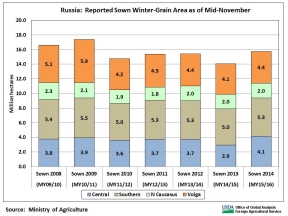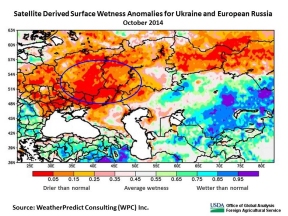Russia: Unfavorable Establishment Conditions for 2015/16 Winter Grains
The sown area for 2015/16 Russia winter grains surpassed last year’s level by 13 percent, but persistently dry weather in major growing regions hampered crop emergence and establishment. The Ministry of Agriculture reported fall-planted area at 16.4 million hectares (not including Crimea), against 14.7 million last year and 15.8 million for 2013/14. Most of the year-to-year increase occurred in the Central District, where persistent rain curtailed the fall sowing campaign for 2014/15 winter crops. Sown area increased by 6 percent in the Southern District (Russia’s top winter-wheat region) and by 5 percent in the Volga District, and remained stable in the North Caucasus District. The sowing campaign benefited from generally dry weather which facilitated rapid planting but the dryness persisted after planting was finished, resulting in the poor establishment conditions.

The fall sowing campaign for winter crops advances from north to south, beginning in mid-August in the Volga District and concluding in the North Caucasus District in mid-November. Wheat is the country’s main winter grain and comprises about 85 percent of the sown area. Rye contributes 11 to 13 percent of the sown area, and winter barley and triticale about 3 and 2 percent, respectively. Winter wheat accounts for about half of Russia’s total wheat area but for almost two-thirds of the output due to higher yield. Winter barley, on the other hand, comprises a relatively small share of the country’s total barley output; spring barley typically accounts for 90 to 95 percent. Virtually all of Russia’s rye and triticale are winter crops.
Unusually dry weather extending from early September through mid-November provided unfavorable conditions for the emergence and establishment of winter crops in every major production region. In the southern Central and southern Volga Districts, dryness prevailed during September (as indicated by microwave satellite imagery) and intensified in October. The October dryness hampered crop establishment in the later-planted Southern and North Caucasus Districts as well, and dryness continued during the first half of November.
The adverse establishment conditions are reflected in satellite-derived vegetative indices. In the Central and Volga Districts and the northern portion of the Southern District, the NDVI (normalized difference vegetative index) from mid-October were substantially below normal and worse than at the same time last year. The NDVI suggest similarly poor November conditions in the southernmost territories. Although winter grains certainly benefit from good establishment and vigorous fall tillering, autumn dryness does not automatically preclude high final yield. Crops can compensate to a large degree if growing conditions are favorable when vegetative growth resumes in the spring.

Minimum temperatures approached minus 30 degrees Celsius in many parts of Russia’s prime winter-wheat zone in early January. Damage to winter crops was likely minimal, however, because of widespread protective snow cover and the brief duration of the cold-weather episode. In a typical year, roughly 5 to 10 percent of the country’s winter crops fail to survive until spring, due to either fall dryness or winter frost. Losses were unusually low last year, at a reported 2.4 percent. Total winter losses for the 2015/16 crop will not be determined until surviving crops break dormancy during March and April.
Initial USDA crop-production estimates for 2015/16 will be released on May 12, 2015.
Current USDA area and production estimates for grains and other agricultural commodities are available on IPAD’s Agricultural Production page, or at PSD Online.
|

